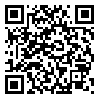Volume 6, Issue 3 (10-2019)
Human Information Interaction 2019, 6(3): 41-54 |
Back to browse issues page
Download citation:
BibTeX | RIS | EndNote | Medlars | ProCite | Reference Manager | RefWorks
Send citation to:



BibTeX | RIS | EndNote | Medlars | ProCite | Reference Manager | RefWorks
Send citation to:
Mokhtari H, shafitabar samakosh N. Koranic Guidelines on Human-Information Interaction. Human Information Interaction 2019; 6 (3)
URL: http://hii.khu.ac.ir/article-1-2886-en.html
URL: http://hii.khu.ac.ir/article-1-2886-en.html
Payame Noor
Abstract: (6104 Views)
Background and aim: Analyzing the newly-emerged field of human-information interaction (HII) needs to study the field from diferent aspects and perspectives. Religious literature, including among others the Koran is one of main resources for doing so. This study aimed to extract and explain the guidelines and main points related to HII by deeply reflecting on Koranic verses and chapters that regard this notion.
Method: By applying Koranic scientific and topical interpretion approach and using a qualitative content analysis, the related guidelines and points were extracted from the Koran by using a comprehensive and popular 10-volumed Persian interpretion book, Tafsīr Nūr authored by an Iranian scholar, Muhsin Qarā‘tī.
Findings: 25 Koranic guidelines on HII were found from the Koran. In total, the Koran has direct and indirect guidelines on HII, including information search, evaluation, dissemination, use and verification, and approaches of sending-receiving and using information.
Conclusion: Considering the Koranic guidelines on HII and conducting further research on them can resolve many challenges of encountring information of any types in the information age
Method: By applying Koranic scientific and topical interpretion approach and using a qualitative content analysis, the related guidelines and points were extracted from the Koran by using a comprehensive and popular 10-volumed Persian interpretion book, Tafsīr Nūr authored by an Iranian scholar, Muhsin Qarā‘tī.
Findings: 25 Koranic guidelines on HII were found from the Koran. In total, the Koran has direct and indirect guidelines on HII, including information search, evaluation, dissemination, use and verification, and approaches of sending-receiving and using information.
Conclusion: Considering the Koranic guidelines on HII and conducting further research on them can resolve many challenges of encountring information of any types in the information age
References
1. Abdallah, S. (2007). Information ethics from an Islamic perspective, in: M. Quigley (Ed.), Encyclopaedia of Information Ethics and Security (pp. 355-361), Australia: Monash University.
3. Albers, M. J. (2008). Human-information interaction. In: Proceedings of the 26th annual ACM international conference on Design of Communication (pp. 117-124). ACM.
5. Albers, M. J. (2015). Human-information interaction with complex information for decision-making, In: Informatics (Vol. 2, No. 2, pp. 4-19), Multidisciplinary Digital Publishing Institute.
7. Fell, L., Gibson, A., Bruza, P., & Hoyte, P. (2020). Human Information Interaction and the Cognitive Predicting Theory of Trust. In: Proceedings of the 2020 Conference on Human Information Interaction and Retrieval (pp. 145-152).
9. Fidel, R. (2012). Human information interaction: An ecological approach to information behavior. MIT Press.
11. Iman, M.T., Novshadi, M.R. (2011). Qualitative content analysis. Research, 3 (2), 15-44.
12. Jones, W., Pirolli, P., Card, S. K., Fidel, R., Gershon, N., Morville, P., ... & Russell, D. M. (2006, April). It's about the information stupid!: why we need a separate field of human-information interaction. In: CHI'06 extended abstracts on Human factors in computing systems (pp. 65-68). ACM.
15. Marchionini, G. (2008). Human-information interaction research and development. Library & Information Science Research, 30(3), 165-174.
17. Masoudipour, S. & Sepehri, M. (2015). Thematic research methodology in the Holy Quran: Designing a practical method for interdisciplinary research. Interrdisciplinary Quranic Studies, 6 (1), 79-98 [in Persian].
18. Mellor, P. A. (2004). Religion, culture and society in the 'information age'. Sociology of religion, 65(4), 357-371.
20. Mingers, J., & Standing, C. (2018). What is information? Toward a theory of information as objective and veridical. Journal of Information Technology, 33(2), 85-104.
22. Naghib, A.R. (2008). Research Methodology in Education (an Islamic Approach). Translated and amended by B. Rafi'i. Qom: Research Institute of Hawzah and University [in Persian].
23. Qarā'tī, M. (2008). Tafsīr Nūr, 10-volumes, Tehran: Lessons from the Koran Pub. [In Persian].
24. Resmini A., Rosati L. (2010) The Semantic Environment: Heuristics for a cross-context human-information interaction model. In: Dubois E., Gray P., Nigay L. (eds), The Engineering of Mixed Reality Systems. Human-Computer Interaction Series. Springer, London. [DOI:10.1007/978-1-84882-733-2_5]
26. Rezaie Isfahani, M. (2004). Introduction to Scientific Interpretation of Quran. Tehran: Osveh Pub [In Persian].
27. Savolainen, R. (2018). Pioneering models for information interaction in the context of information seeking and retrieval. Journal of Documentation.Sedig, K. & Parsons, P. (2015). Human-Information Interaction-A Special Issue of the Journal of Informatics. Informatics, 2 (1), pp. 1-3.
29. Wilson, T. D. (2000). Human information behavior. Informing Science, 3(2), 49-56.
Send email to the article author
| Rights and permissions | |
 | This work is licensed under a Creative Commons Attribution-NonCommercial 4.0 International License. |






